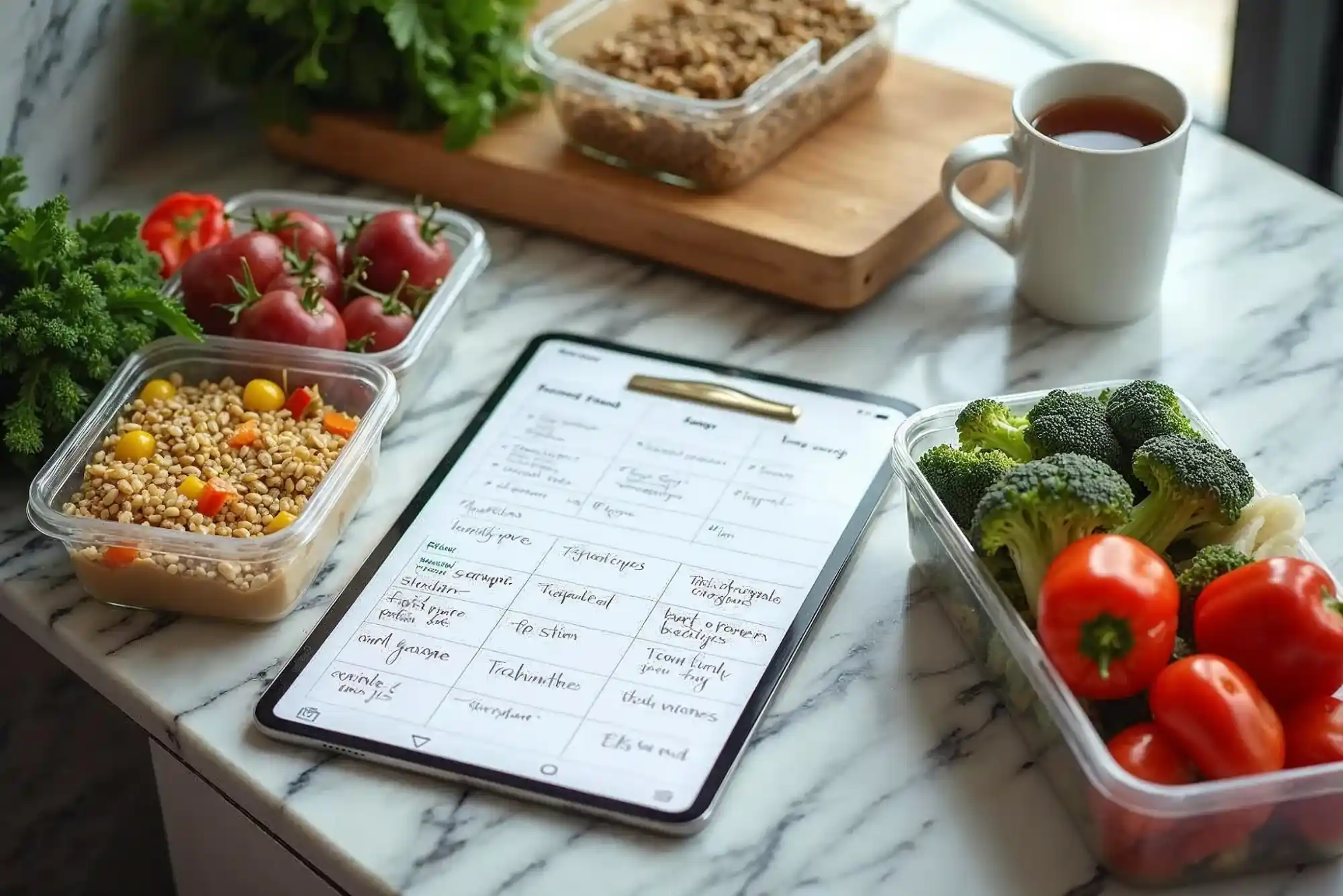Let’s be honest, most people don’t stick to meal planning.
You start with good intentions, maybe scribble a few dinners on a sticky note or download a Pinterest template, but by Wednesday? You’re back to takeout and impulse groceries.
Sound familiar?
The problem isn’t that meal planning doesn’t work, it’s that most plans are too complicated, too strict, or don’t fit your real life. Between work schedules, cravings, kids, or just sheer decision fatigue, it’s easy to ditch the plan when it doesn’t feel doable.
But here’s the good news:
You don’t need to be a professional chef, nutritionist, or spreadsheet junkie to make a meal plan that actually sticks.
In this post, we’ll walk you through a practical, six-step approach to creating your own healthy meal plan, one that’s flexible, sustainable, and customized to your lifestyle. No fluff, no rules, you can’t keep just a system that helps you eat better, waste less, and take back control of your food habits.
Let’s simplify it, once and for all.
Why DIY Works Better
There’s no shortage of fancy meal plans, apps, or diet fads promising to “fix” your eating habits overnight. But here’s the truth: when you build your own meal plan, it works better because it works for you.
Think about it.
You know your cravings. You know your schedule. You know what your family will actually eat and what they’ll leave untouched on the plate.
A DIY meal plan gives you full control:
- Cost: You can plan meals around what’s already in your pantry or what’s on sale no more overspending on one-time ingredients.
- Health: You choose the ingredients, the portion sizes, and the balance, not a generic calorie app or a one-size-fits-all “diet.”
- Flexibility: If your week changes (because it always does), so can your meals. You’re not stuck with a rigid plan that collapses at the first unexpected dinner invite.
When you create your own system, you’re not just following someone else’s routine, you’re designing a way of eating that fits your life, not the other way around.
The 6-Step Meal Planning System That Actually Works
Forget rigid templates and Pinterest-perfect plans. This six-step system is designed for real life whether you’re feeding a family, managing your health goals, or just trying to stop the endless “what’s for dinner?” cycle.
Step 1: Review Your Week
Start by looking at your calendar, not your fridge.
If you’ve got late meetings, school pickups, or social plans, those nights need quicker or pre-prepped meals. Planning without knowing your schedule is like packing for a trip you haven’t booked, pointless and stressful.
Ask yourself:
- How many meals do I actually need this week?
- Which nights will be rushed or relaxed?
- Do I already have dinners planned out (dining out, leftovers, etc.)?
Pro tip: Don’t plan 7 dinners. Plan 4–5 max. Leaving room for spontaneity and leftovers makes the plan more flexible and sustainable.
Step 2: Check Your Pantry and Fridge
Before writing down anything new, check what you already have.
That half-bag of quinoa, lone zucchini, or frozen chicken breast? They’re money sitting in your kitchen. Use them.
Go shelf by shelf and list what’s usable. Focus on perishables that need to go first; this keeps your grocery bill lower and waste down.
Create a “Use This First” list
- Highlight proteins, carbs, and vegetables already on hand
- Check for spice blends, sauces, and pantry staples
This step alone can save you 30–40% on your grocery run especially in Dubai, where imported food costs can stack up fast.
Step 3: Pick Your Recipes
Here’s where most people get overwhelmed.
You don’t need 20 new recipes each week. You need 3–5 core meals that are quick, balanced, and enjoyable. Rotate them with variations.
- Use the “Protein + Carb + Veg + Sauce” formula
- Pick at least one one-pot meal and one no-cook or assembly meal
- Consider batch-cook options for lunches (grain bowls, pasta, curries)
Example:
- Grilled chicken with sweet potato mash and green beans
- Chickpea salad with tahini dressing
- Biryani with cucumber raita
- Basiligo-style macro bowl with quinoa, tofu, and spicy peanut sauce
Keep a “meal bank” , a saved list of go-to recipes you love. Add to it every few weeks. Soon, planning becomes plug-and-play.
Step 4: Schedule Your Meals
Now, match your chosen meals to your real schedule.
- Use a weekly planner, either physical or digital
- Assign meals to days based on time, energy, and prep
- Identify where leftovers can be reused
- Slot in easy meals for busy days or consider a Basiligo backup
Example layout:
| Day | Dinner | Notes |
| Monday | Chicken stir-fry | Quick, post-work meal |
| Tuesday | Lentil soup | Batch prep for 2 nights |
| Wednesday | Leftover soup with salad | Light day |
| Thursday | Grilled fish with quinoa | More cooking time available |
| Friday | Eating out or Basiligo meal | Keep it open |
Visualizing your week reduces decision fatigue, one of the biggest reasons people abandon their meal plan.
Step 5: Build Your Grocery List
This is where DIY gets tactical.
Using your recipe list, build a category-based shopping list:
- Protein
- Vegetables
- Carbohydrates
- Pantry staples
- Snacks
- Extras (sauces, herbs, condiments)
Cross-check your list with what’s already in your kitchen from Step 2. This prevents duplicates and avoids “I thought I had that” moments at checkout.
Apps like AnyList, Google Keep, or even pen and paper work fine. The key is consistency.
If you’re shopping in the UAE, try to align your list with local store offers. Carrefour, Union Coop, and online grocers often run weekly deals that can help cut costs.
Step 6: Cook and Iterate
Here’s where the plan becomes action but also where flexibility is key.
You don’t have to cook everything from scratch each night. Batch-cook on weekends, prep ingredients in advance (like chopping vegetables or marinating proteins), or cook double portions for leftovers.
Most importantly, observe what works and what doesn’t.
Reflect each week:
- Did you actually enjoy the meals?
- Did any ingredients go to waste?
- Were any recipes too time-consuming?
- Did life throw you a curveball?
Adjust your plan based on what you learn. That’s the iterate part.
Over time, you’ll notice patterns: what meals you fall back on, what’s worth prepping ahead, what days need low-effort options. That’s how DIY meal planning evolves from a chore into a habit one that truly works.
Pro Tips for Sticking With It
Even with a great plan, life happens. You’ll get busy, bored, or tempted to fall back into old habits. That’s normal, the trick isn’t to be perfect, it’s to make the system resilient.
Here’s how to stay consistent without burning out:
1. Plan Meals You Actually Look Forward To
Don’t fill your week with meals you feel you “should” eat but secretly hate. If you’re not excited about dinner, you’re more likely to ditch the plan and order in. Prioritize flavor and satisfaction. Healthy can still taste amazing.
Think: comfort meals made cleaner, not joyless salads.
2. Celebrate Small Wins
Consistency isn’t about meal-prepping seven days in a row. It’s about stringing together small wins three home-cooked meals instead of none, using up what’s in your fridge, trying one new recipe.
Give yourself credit. Progress > perfection.
3. Always Build in Backup Options
The plan will break sometimes that’s expected. Build in fallback meals:
- A frozen batch-cooked dinner
- A five-minute “assembly meal”
- A Basiligo ready-made option for chaotic days
Having a backup prevents panic and keeps you from throwing the whole plan out.
In short, meal planning works when it fits your lifestyle, not when it tries to control it. Keep it flexible, keep it enjoyable, and keep learning what works best for you.
Sample One‑Week DIY Meal Plan
Here’s what a realistic, low-stress DIY meal plan looks like in action. It includes variety, batch-cook opportunities, and built-in breathing room.
| Day | Dinner | Prep Notes |
| Monday | Grilled chicken + quinoa + roasted carrots | Double cook quinoa for Wednesday’s bowl |
| Tuesday | Lentil and vegetable soup | Make a large batch — use for lunch or Thursday leftovers |
| Wednesday | Quinoa veggie bowl with tahini dressing | Assemble from Monday’s quinoa + fresh toppings |
| Thursday | Leftover lentil soup + whole-grain toast | Easy reheat night |
| Friday | Basiligo meal or healthy takeout | Keep it open — low-effort night |
| Saturday | Biryani with cucumber raita | Batch cook and store extra for Sunday lunch |
| Sunday | Zucchini pasta with pesto + side salad | Use any leftover vegetables from earlier in the week |
Key Planning Tips:
- Double up when it makes sense — grains, sauces, soups.
- Use easy assembly meals midweek when motivation dips.
- Keep Friday flexible — no plan survives a busy week perfectly.
- Sunday night can be light and fresh, helping you reset for the next week.
Common Pitfalls & How to Fix Them
Even with the best intentions, meal planning can fall apart. Here’s how to spot the usual traps and get ahead of them.
1. Burnout from Overplanning
Planning every single meal, cooking daily, and prepping too much can backfire fast.
Fix: Only plan 4–5 dinners per week. Leave room for flexibility, leftovers, or simple fallback meals like eggs on toast or a Basiligo ready-made dish.
2. Too Much Repetition
Eating the same 2–3 meals on repeat can lead to food fatigue.
Fix: Rotate ingredients in different combinations. Example: grilled chicken in a wrap one night, in a salad the next. Keep a “meal bank” so you’re not always starting from scratch.
3. Grocery Budget Overruns
Buying recipes without checking what’s already at home leads to waste and overspending.
Fix: Always do a pantry check first. Build your plan around what you already have, then shop for the gaps.
4. All-or-Nothing Thinking
Missing one meal can make you feel like the plan failed.
Fix: One off-day doesn’t cancel progress. Adjust and move on. That’s part of the process.
Smart planning isn’t rigid, it’s adaptable.
Conclusion: Start Simple, Stay Flexible
Meal planning doesn’t have to be complicated to be effective. The key is to start with what fits your lifestyle, test it out, and refine as you go. Even planning just a few meals each week can help you save time, reduce stress, and eat better without the overwhelm.
Remember it’s not about doing it perfectly, it’s about doing it consistently.
And if you ever need a break from the kitchen, or just want healthy meals without the effort, we’ve got your back.
Explore Basiligo’s chef-curated meal plans tailored to your goals, delivered to your door, and built to complement your lifestyle.
Browse Meal Plans Dubai
Start with one change this week your future self will thank you.
Frequently Asked Questions (FAQs)
1. How do I start meal planning if I’ve never done it before?
Start simple. Plan just 3–4 dinners for the week based on your schedule and what’s already in your fridge or pantry. Use repeatable meal formulas like “protein + carb + veg” and build from there. The key is to start small and build consistency, not perfection.
2. How much time does meal planning take each week?
Once you get the hang of it, you can plan your week in under 30 minutes. Checking your calendar, scanning your pantry, picking 3–5 meals, and writing your grocery list is usually all it takes. Over time, you’ll build a personal “meal bank” that makes it even faster.
3. Can meal planning help me save money in Dubai?
Absolutely. By planning meals around what’s already at home and shopping with a list, you avoid impulse buys and reduce waste. It’s especially useful in Dubai where imported food can be expensive — smart planning can cut your grocery bill by 25–40%.
4. What if I don’t have time to cook every night?
You don’t have to. Meal planning is about making life easier, not harder. Cook in batches, use leftovers creatively, and always have one or two fallback options (like a Basiligo ready-made meal) to stay on track even during busy weeks.
5. Is DIY meal planning better than using a meal delivery service?
It depends on your goals. DIY gives you full control over ingredients, cost, and flexibility. But when life gets hectic, combining your own plan with a trusted meal delivery service like Basiligo helps you stay consistent without burnout.




